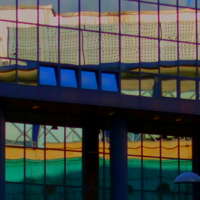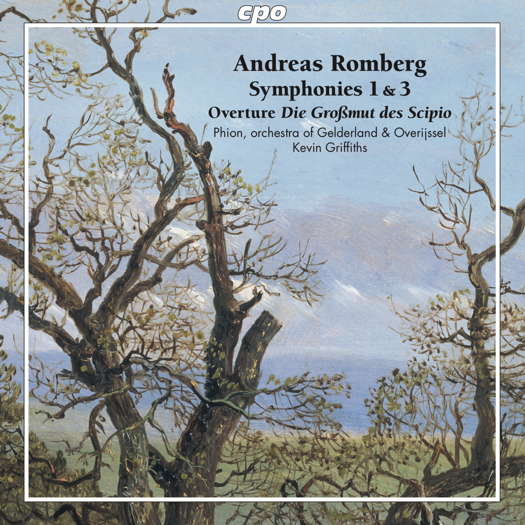 CENTRAL ENGLAND: Mike Wheeler's concert reviews from Nottingham and Derbyshire feature high profile artists on the UK circuit - often quite early on their tours.
CENTRAL ENGLAND: Mike Wheeler's concert reviews from Nottingham and Derbyshire feature high profile artists on the UK circuit - often quite early on their tours.
- Daniel Catán
- Venice
- Stephen Kovacevich
- A P Virag
- Judaism
- Vox Classics
- Gerard Hoffnung
- Alban Gerhardt
ARTICLES BEING VIEWED NOW:
- Régine Crespin
- Hector Berlioz
- Ruth Railton
- Marián Varga
- Profile. A Very Positive Conductor - Paul Bodine talks to Los Angeles Opera's Music Director Designate, Domingo Hindoyan

Contrapuntal Mastery
GERALD FENECH listens to an overture and symphonies by Andreas Romberg
'Kevin Griffiths and his Dutch players etch out some bright and eminently satisfying performances, and their advocacy for this music brims with enthusiasm.'
Born on 27 April 1767, Andreas Romberg is considered to be a very important link between the Classical and Romantic eras. His family was extremely musical with many branches, and as a child he flourished, becoming an excellent violinist. He received his first tuition in Münster, together with his cousin Bernhard Romberg, an equally talented cellist and composer, and both made extensive concert tours early in life. Starting in 1790, Andreas played in the court orchestra in Bonn, and in 1793 he moved to Hamburg, working as a musician and composer. He remained there till the end of the Napoleonic Wars in 1814, after which he was appointed as the conductor at the Gotha court, succeeding Louis Spohr.
Andreas Romberg was highly esteemed as a celebrated violin virtuoso, concert master and composer, and his fame spread to the most important musical European cities such as Paris, Vienna, Prague and Rome. He met Beethoven (who was just three years younger), Haydn and a score of other musical luminaries of his day. For his contribution to German music he received an honorary doctorate from Kiel University in 1809.
His output is profuse indeed, and it includes sacred and secular vocal music which was much admired, eight operas, several instrumental pieces, ten symphonies, violin concertos, overtures and chamber music. By the time of his death on 10 November 1821 aged fifty-four, much of his works had already fallen by the wayside and, after, the name of Andreas Romberg was put on the shelves of German musical history, to remain there till the early 1990s.
The credit for the rediscovery of this composer is, above all, thanks to the Andreas Romberg Project at the University of Vechta (his place of birth). Since 1993, it has systematically researched the composer's works and, today, under its director Klaus G Werner, continues to promote Romberg indefatigably. The musicologist also maintains the scores of the Romberg Edition. The Andreas Romberg Society Vechta, founded in 1995, is also doing sterling work towards the cause.
The Overture, Op 54, is from Romberg's last opera, The Magnanimity of Scipio, a one-act piece composed in 1816. It was written on the occasion of the forty-fourth birthday of his patron Duke August of Saxony-Gotha-Altenburg on 23 November. The plot revolves around the time of the Roman commander Publius Cornelius Scipio Africanus (235-183BC) and his wars against Carthage. Following a battle, he does not keep prisoner Panthea as a hostage but restores her to her betrothed Allucius. The commander even gives her back the ransom money offered by the bridegroom as a wedding gift. Scipio is indeed a role model for ruling monarchs. Published separately in 1818 for concert purposes, this vibrant work refers to the mood of the old Italian opera seria, and in contrast, Romberg's orchestration, complete with three trombones, points towards the French operatic tradition. The Overture has many different and contrasting themes that represent the heroic and the tender aspects of the story, and the final coda, anticipating the happy outcome of the opera, is exhilarating in its cheeriness and optimism.
Listen — Romberg: Overture (Die Großmut des Scipio)
(track 1, 4:24-5:15) ℗ 2021 cpo :
Andreas Romberg composed a total of ten symphonies, but only six have survived, and only four were printed during his lifetime. In his day, these symphonies were extremely popular and were even held at par with those of Mozart, Haydn and Beethoven. Indeed, for a time Romberg's symphonies were near to achieving the number of performances as those of the First Viennese School.
The Symphony No 1 was composed in Hamburg between 1793 and 1794, but was only published in 1805 by Hoffmeister and Kuhnel in Leipzig. Performed in Hamburg, Leipzig and Frankfurt am Main, the work received high praise, and was described as 'pure, clear, clean, without pomp and excess and full of cheerful grace.'
Listen — Romberg: Andante (Symphony No 1)
(track 3, 0:00-0:51) ℗ 2021 cpo :
The Third Symphony was composed in 1797, also in Hamburg, and it was in this city that it received its premiere on 12 November of that same year. The score had to wait till the turn of 1812-13 to be published, also in Leipzig and by the same publishers of the First. Other performances are documented after this date, such as in Dessau in 1837.
Listen — Romberg: Allegro vivace (Symphony No 3)
(track 6, 7:42-8:40) ℗ 2021 cpo :
Both works are in the classical four-movement form, and the music is, as expected, much akin to Haydn and Mozart, but Romberg shows himself as an innovator as well, and he was very careful to avoid derivative elements. Indeed, his contrapuntal mastery and splendidly arranged fugues were much admired aspects of his compositions.
Kevin Griffiths and his Dutch players etch out some bright and eminently satisfying performances, and their advocacy for this music brims with enthusiasm. An invaluable addition to the discography of a composer who is still waiting for recognition on the bicentenary of his death.
Copyright © 15 September 2021
Gerald Fenech,
Gzira, Malta

CD INFORMATION - ROMBERG: SYMPHONIES 1 AND 3
CLASICAL MUSIC ARTICLES ABOUT GERMANY


